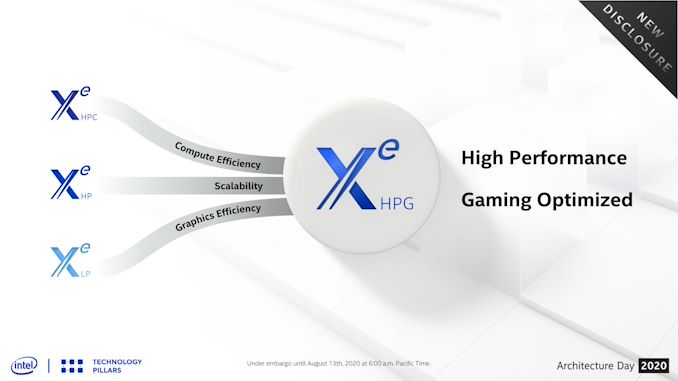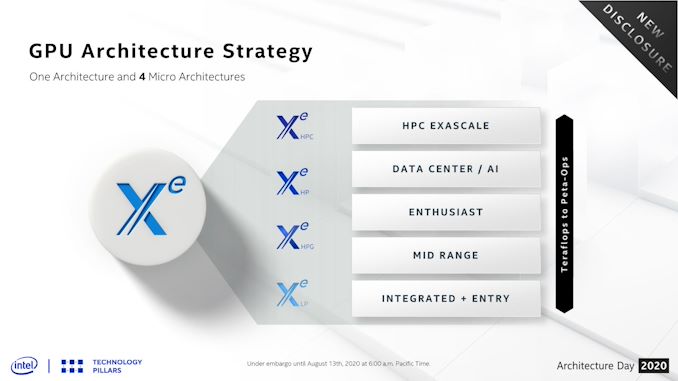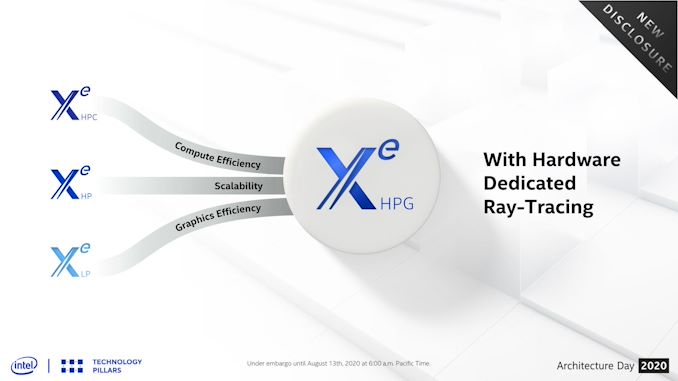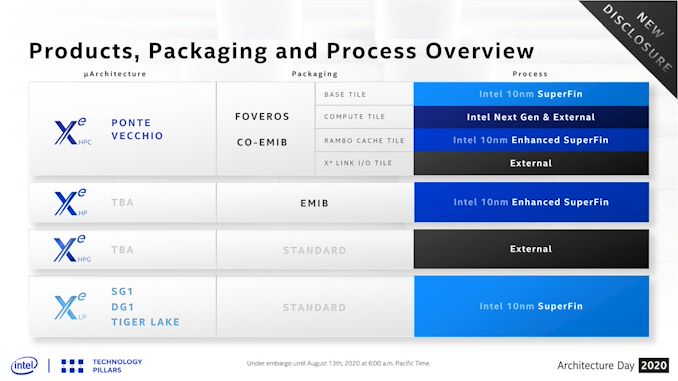Intel’s Xe-HPG GPU Unveiled: Built for Enthusiast Gamers, Built at a Third-Party Fab
by Ryan Smith on August 13, 2020 9:40 AM EST- Posted in
- GPUs
- Intel
- DirectX 12
- Xe
- Ray Tracing
- Xe-HPG

Among the many announcements in today’s Intel Architecture Day, Intel is also offering a major update to their GPU roadmap over the next 24 months. The Xe family, already jam-packed with Xe-LP, Xe-HP, and Xe-HPC parts, is now getting a fourth planned variant: Xe-HPG. Aimed directly at the enthusiast gamer market, this latest Xe variant will be Intel’s most gaming-focused part yet, and the biggest step yet in Intel’s plans to be more diversified in its foundry sources.
So what is Xe-HPG? At a high level, it’s meant to be the missing piece of the puzzle in Intel’s product stack, offering a high-performance gaming and graphics-focused chip. This is as opposed to Xe-HP, which is specializing in datacenter features like FP64 and multi-tile scalability, and Xe-HPC which is even more esoteric. In that respect, Xe-HPG can be thought of as everything in the Xe family, distilled down into a single design to push FLOPs, rays, pixels, and everything else a powerful video card might need.
Like with the rest of Intel’s forward-looking Xe announcements, the company isn’t offering performance projections, features, or the like. But we do have some small details on what to expect.
First and foremost, beyond going after the enthusiast performance space, Intel has confirmed that this part will support ray tracing. A marquee feature of high-end video cards, ray tracing will take on even greater important over the coming years as the soon-to-launch next-generation consoles head out the door with the feature as well, eventually transforming it into a baseline feature across all gaming platforms. Similarly, ray tracing is a critical component of Microsoft’s DirectX 12 Ultimate standard, which given the timing of this GPU and Intel’s intentions, I would be shocked if Intel didn’t support in full.
The chip will be built on the foundation that is Xe-LP. However it will also pull in technologies that Intel is pioneering for Xe-HP, and Xe-HPC. Not the least of which is raw scalability, which is being able to take the Xe-LP foundation and scale it up to hundreds (if not thousands) of GPU execution units. But Intel is also pulling what they are calling “compute frequency enhancements” from Xe-HPC, which presumably will allow them to maximize the chip’s overall clockspeeds. All told, I won’t be too surprised if it looks a lot like Xe-HP in general, except with server-driven features like fast FP64 support and multi-tiling stripped out.
But Xe-HPG will also bring something new to the table for the entire Xe family: GDDR6 support. Intel is confirming that the chip – or rather, the microarchitecture the chip will be based on – will be designed to work with GDRR6. This is as opposed to Xe-HP(C), which as high-end server parts use HBM, and Xe-LP, which is designed for use with more conventional memory types. GDDR6 compatibility is a unique need that reflects this is a gaming focused part: GDDR6 provides the memory bandwidth needed for high-performance graphics, but without the stratospheric costs of HBM memory (a problem that has impacted some other high-end GPUs over the years). In a further twist, Intel apparently licensed the GDDR controller IP from outside the company, rather than developing it in-house; so Xe-HPG will have a very notable bit of external IP in it.
But perhaps most interesting of all for graphics insiders and Intel investors alike is where Xe-HPG will be built: not at Intel. As part of their Architecture Day roadmap, Intel has confirmed that the part will be made at an external fab. In fact it’s the only Xe part where the GPU (or at least the compute element) is being made entirely at a third-party fab. Intel of course will not reveal which fab this is – if it’s TSMC or Samsung – but it means we’re going to see a complete Intel GPU built at another fab. If nothing else, this is going to make comparing Xe-HPG to its AMD and NVIDIA rivals a lot easier, since Intel will be using the same fab resources.
Looking at the same roadmap, it’s worth pointing out that Intel won’t be using any of their advanced packaging technologies for the part. Since they’re not using HBM and they’re not doing multi-tiling, there’s no need for things like EMIB, never mind Foveros. There’s still a lot of unknowns with the cost aspects of Intel’s advanced packaging technologies, so keeping it out of Xe-HPG will presumably help keep costs in check in a very competitive marketplace.
And that is the scoop on Xe-HPG. The latest and most gaming-focused member of Intel’s Xe GPU product stack is set to launch in 2021 – and as Intel looks to break into the wider GPU market, I don’t doubt for a second that this won’t be the last we’ll hear of it between then and now.













39 Comments
View All Comments
vladx - Thursday, August 13, 2020 - link
Did you really thought Intel changed ship towards using 3rd party fabs just last month?fogifds - Thursday, August 13, 2020 - link
Intel does have R&D fabs, so they can test and run processes before going live. It's not like one day you hit save on gpu.asm and droxbox it to TSMC to run with.rahvin - Saturday, August 15, 2020 - link
You do realize you can't move a mask from one fab to another right? The design from the ground up is based on the process tech of the fab it's going to be made in. The entire design has to be customized to the fab.Wouldn't do you any good at all to tape out on one of their R&D fabs then go to somewhere else. Either they've used the masks and taped out on an outside fab or they did it internal and are planning to do it themselves. They wouldn't spend the $2million+ on a tape out they'd have to throw out the door when they switch manufacturers.
Strega315 - Thursday, August 13, 2020 - link
We were manufacturing Intel chips at WaferTech LLC (Camas, WA - TSMC subsidiary) for 20 years or more. I've been employed by both WaferTech and Intel, and both NVIDIA GPU chips and Intel chips were being manufactured on the same equipment for decades now, I was in Ion Implantation with Varian (now AMAT) implanters all through the 2000's and 2010's. Foundry operations save companies like Intel Millions if not Billions of dollars and they simply make good financial sense.Toe - Thursday, August 13, 2020 - link
Anybody seen any pigs flying lately? That's when I'll believe Intel has legit gaming GPUs.sorten - Friday, August 14, 2020 - link
Yeah, I'm definitely not buying Gen 1 Xe. I'll wait for reviews and for driver support issues to be sorted out, at least. But I'm glad we're going to have a 3rd player in the discrete GPU market.rahvin - Saturday, August 15, 2020 - link
The big test will be if Intel is actually committed to gpu design and moves forward. Remember, they've done dGPU before and abandoned the effort a year later.probablynotme - Thursday, August 13, 2020 - link
But can it play Crysis?MrVibrato - Friday, August 14, 2020 - link
If you pair it with a Threadripper, i guess so...Strega315 - Thursday, August 13, 2020 - link
I'm guessing this will be built up in Camas, WA at TSMC subsidiary WaferTech LLC. - former Intel, IBM, AMAT, & WaferTech semiconductor manufacturing Tech.